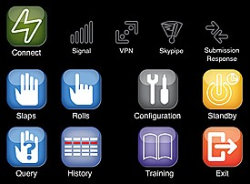Dec 16 2009
The Federal Bureau of Investigation (FBI) Hostage Rescue Team had a problem—they needed a small, portable tool to identify fingerprints and faces, but couldn’t get anyone interested in building a solution for such a limited market. So they came to the National Institute of Standards and Technology (NIST).
 A NIST team has prototyped a new handheld touch-screen application, a fingerprint identification system suitable for use by the FBI's Hostage Rescue Team
A NIST team has prototyped a new handheld touch-screen application, a fingerprint identification system suitable for use by the FBI's Hostage Rescue Team
The FBI told NIST they wanted something more portable than the 20-pound rugged laptop plus fingerprint scanner their hostage rescue teams lug around to aid in their anti-terrorism efforts, and this led to NIST developing a new application for a handheld touch-screen device.
The original task given to NIST by the FBI was simply to design and compile the requirements for the software the FBI needed to run on their platform of choice: a handheld device with a touch screen about the size of an index card. Paring down the visual interface to a mini-screen requires detailed understanding of what functionalities are most important. NIST researchers Mary Theofanos, Brian Stanton, Yee-Yin Choong and Ross Micheals brainstormed with the FBI team about what they required and, more importantly, watched them doing their work since most people can demonstrate what they need far better than they can articulate it.
The research paid off. Despite having worked closely with the NIST team, even the FBI Hostage Rescue Team was surprised at how well the ultimate design matched their needs: a small tool that could take pictures of fingerprints or faces and send the data wirelessly to a central hub for analysis, all with a minimum of touch strokes.
But Theofanos, Stanton and Choong wanted to take the program further. Smart phones with touch screen devices were becoming available—could they scale their design down even more to fit a 2-inch x 3-inch screen? The team created a demo program for just such an available screen—and it scaled beautifully.
The NIST team already had been collaborating with other security agencies on something called Mobile ID, a method to help officers identify people quickly and easily on the scene, instead of taking people back to headquarters to be fingerprinted. The NIST researchers think this demo program might just be the solution. The next step is to integrate an actual finger print sensor into the demo program.